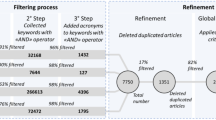Abstract
The aided decision processes are expected to improve the design tasks by the reduction of uncertainty, which is one of the principal aspects that interferes with designer choices. These methods can optimise the problem solution by the time reduction in the iterative decision-cycles that can be based on previous knowledge. This article is based in the utilisation of a knowledge based method in design heuristics, which are defined as a set of procedures that allows both, discovery and acquisition, of a solution for a particular problem by the implementation of a strategy, guided by knowledge derived from the experience. This is applied to design area by the extrapolation of technical or conceptual knowledge that has been previously applied and proven in similar problem-solving processes and providing reference points within designs processes as well. For this reason the research focuses on the development of a design case in order to evaluate the interaction between the user and the guided problem approach. The objective was the analysis between two different design processes by the comparison of the implementation of heuristics based method and conventional design techniques in a design case. The purpose was to compare the outcomes of both experiments, taking as a basis the following setup: The design case proposed was carried out by two different teams, where the first team was instructed to use conventional problem-solving approaches such as Pahl & Beitz and Ulrich & Eppinger and the second one was intended to use the heuristics based method. The design task given to both teams was the development of a methane production system by the use of organic waste with the incorporation of technologies to allow the variables control, in other words, an automated biodigester; this allows to have an outcome all teams easy to comparable between each other. Each team performed the task separately, in order to avoid external influence in the process. All of this to proof that with the aid of tools based on heuristic strategies might enhance the innovation and diversification in design alternatives and strengthens conceptual exploration by providing more detailed concepts in early stages of the process.











Similar content being viewed by others
Notes
Method for the implementation of heuristics in the design process presented by Arts et Métiers ParisTech from France and Universidad EAFIT from Colombia.
Reactor where the digestion of organic waste matter takes place by the use of anaerobic bacterias.
1 EUR = 3200 COP.
References
Altshuller, G., Shulyak, L., Rodman, S.: 40 Principles: TRIZ Keys to Innovation, vol. 1. Technical Innovation Center, Inc., Worcester (1997)
Beheshti, R.: Design decisions and uncertainty. Des. Stud. 14(1), 85–95 (1993)
Calle-Escobar, M., Mejía-Gutiérrez, R., Nadeau, J.P., PAILHES, J.: Methodology for the implementation of heuristics in the design process. In: Virtual Concept Colombian International Workshop, pp. 1–7 (2014)
Cross, N.: Descriptive models of creative design: application to an example. Des. Stud. 18(4), 427–440 (1997)
Daly, S.R., Yilmaz, S., Christian, J.L., Seifert, C.M., Gonzalez, R.: Design heuristics in engineering concept generation. J. Eng. Educ. 101(4), 601–629 (2012)
Dylla, N.: Thinking methods and procedures in mechanical design. Ph.D. thesis, Technical University of Munich, Munich, Germany (1991)
Fischer, X., Coutellier, D.: Research in Interactive Design: Proceedings of Virtual Concept 2005. Springer, New York (2006)
Fischer, X., Nadeau, J.P.: Interactive design: then and now. Research in Interactive Design, Vol. 3. Springer, Paris, pp 1–5
Hernandez, N.V., Okudan, G.E., Schmidt, L.C.: Effectiveness metrics for ideation: merging genealogy trees and improving novelty metric. In: ASME 2012 International Design Engineering Technical Conferences and Computers and Information in Engineering Conference, pp. 85–93. American Society of Mechanical Engineers (2012)
Hernandez, N.V., Shah, J.J., Smith, S.M.: Understanding design ideation mechanisms through multilevel aligned empirical studies. Des. Stud. 31(4), 382–410 (2010)
Pahl, G., Beitz, W., Feldhusen, J., Gote, H.: Engineering Design: A Systematic Approach. Springer, New York (2007)
Perry, N., El Amine, M., Pailhès, J.: Exploring design space in embodiment design with consideration of models accuracy. CIRP Annals-Manufacturing Technology (2015)
Roozenburg, N.F., Eekels, J.: Product Design: Fundamentals and Methods, vol. 2. Wiley, Chichester (1995)
Shah, J.J., Kulkarni, S.V., Vargas-Hernandez, N.: Evaluation of idea generation methods for conceptual design: effectiveness metrics and design of experiments. J. Mech. Des. 122(4), 377–384 (2000)
Shah, J.J., Smith, S.M., Vargas-Hernandez, N.: Metrics for measuring ideation effectiveness. Des. Stud. 24(2), 111–134 (2003)
Simon, H.A.: The Sciences of the Artificial, vol. 136. MIT Press, Cambridge (1996)
Toh, C.A., Miller, S.R.: The impact of example modality and physical interactions on design creativity. J. Mech. Des. 136(9), 091004-1–091004-8 (2014)
Toh, C.A., Miller, S.R.: How engineering teams select design concepts: a view through the lens of creativity. Des. Stud. 38, 111–138 (2015)
Acknowledgements
The authors gratefully acknowledge Colciencias and its program Joven Investigador, to the French Embassy in Colombia, Colombian Ministry of Education, Colombian association of universities (ASCUN), Colfuturo and Universidad EAFIT for the sponsorship during the research.
Author information
Authors and Affiliations
Corresponding author
Rights and permissions
About this article
Cite this article
Restrepo, J., Ríos-Zapata, D., Mejía-Gutiérrez, R. et al. Experiences in implementing design heuristics for innovation in product design. Int J Interact Des Manuf 12, 777–786 (2018). https://doi.org/10.1007/s12008-017-0422-z
Received:
Accepted:
Published:
Issue Date:
DOI: https://doi.org/10.1007/s12008-017-0422-z




